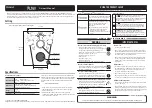
Appendix D: Using a Model 82 C-V System
Model 4200A-SCS Parameter Analyzer Reference Manual
D-4
4200A-901-01 Rev. C / February 2017
Simultaneous C-V measurements
For simultaneous C-V measurements, the 590 and 595 both measure capacitance during the same
voltage sweep. The readings from the two instruments are synchronized using external triggering and
are taken alternately during the sweep.
The figure below shows a simplified representation of the stepped bias voltage supplied by the 595
during a measurement sweep. Each vertical voltage step size is determined by the programmed 595
bias step, while each horizontal time step is determined by the programmed delay time.
A quasistatic measurement is a two-step process that requires at least two charge measurements.
Initially, at the end of step S
1
, the first charge measurement, Q
1
, is made, after which the voltage goes
to the next step. Following the programmed delay period, the Q
3
charge measurement is made, and
the capacitance is then calculated from these values and the step size. Here we see that two voltage
steps are necessary for every low-frequency capacitance measurement.
The 590 is triggered one delay time after the completion of each 595 reading. As a result, high-
frequency measurements are made on only every other step (as represented by the small rectangles
in the waveform figure). Also, the high-frequency measurements are not made at exactly the same
voltage as the quasistatic measurements. High-frequency capacitance measurements CH
m
and
CH
m+1
are made at voltages VH
m
and VH
m+1
, respectively. Quasistatic measurements result from the
charge transfer as the voltage transitions from one step to the next, so that quasistatic capacitance
measurement CQ
m
is reported at a voltage half-way between the voltages at which its charge
measurements Q
1
and Q
3
are made, which is VQ
m
= (V
n
- 0.5*V
step
).
To compensate for this voltage skew, an adjusted quasistatic capacitance value is calculated by
interpolation to correspond to the voltages at which the high frequency measurements were made.
The result is a new array of capacitance values CQ'
n
corresponding to each high frequency result,
CH
n
and VH
n
.
CQ'
n
= CQ(VH
n
) = CQ
m
+ [(CQ
m+1
−
CQ
m
) / (VQ
m+1
−
VQ
m
)] * (V
step
/2) = CQ
m
+ [(CQ
m+1
−
CQ
m
) / 4]
See
(on page D-9) for details on the test to perform simultaneous C-V
measurements.
Details on all parameters for the test are provided in the
(on page 6-313) for the
(on page D-33).
As shown in the following figure, the first high frequency measurement (CH1) is made during the
second phase of the voltage sweep. Only quasistatic capacitance (C1) is measured during the first
phase and is disregarded.
















































